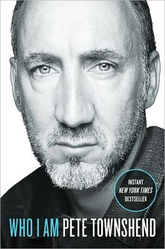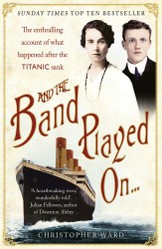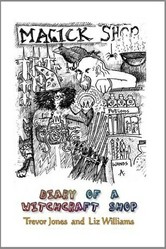Pete Townshend is a brilliant writer and lyricist, but there are many things the public does not know about him. He was often overshadowed by the antics of other members of the Who, although he wrote most of the songs and lyrics that were sung. Here he tells us much about his life, though this writer still believes Pete expresses himself better in his songs, that we get a clearer picture of the man in his lyrics. But if you are a Who fan, this is a book you must own!

Pete Townshend's Autobiography--Who I Am
by JeanBakula
Pete Townshend has released his much anticipated autobiography, so we can finally learn more about his life, his adventures as a member of the Who, and his future plans.
The Who's Creative Genius
Pete Townshend's Achievements
Pete Townshend, the creative genius and leader of the revered rock group The Who, has finally released his much anticipated autobiography. The man behind blue eyes has bared his soul in this revealing, thoughtful, and extremely critical view of himself. He has also been very generous with praise regarding other artists he has worked with throughout his fascinating career, among them The Beatles, The Kinks, The Rolling Stones, The Birds, Eric Clapton, Jimmy Hendrix, and others. He also credits Roger Daltry for being the “leader” of The Who, although Townshend wrote all the music and lyrics for most of their work. Daltry is responsible for getting the group members together though. Pete clearly loved all his band mates, and makes this very clear.
Townshend has the perfect chance here to crow about his numerous achievements, as a lead guitarist, songwriter, composer, author and literary editor. But he seems to want to use this opportunity to dig deep and help his fans understand him better. Pete wants to tell us he is vulnerable and has as many, if not more, faults than all of us. He is still apparently looking within to figure out exactly who he is, and seems satisfied that the answers he sought for so long have been found.
Who I Am
Autobiography of Pete Townshend
 | Who I Am: A Memoir From the voice of a generation: The most highly anticipated autobiography of the year, and the story of a man who... is a Londoner and a Mod.... wanted The Who to be called The ... |
Rock Operas by Pete Townshend
Tommy and Quadrophenia
 | Tommy The famed rock opera's been released on CD several times, but this time it's mixed *for the first time on CD* from the original two-track stereo mixdown master! And the band has... |
 | Quadrophenia The Who's other rock opera, completely remixed and remastered under the supervision of Pete Townshend. |
Pete Townshend's Childhood
Musical Family, Signs of Abuse
Pete came from a musical family—his Father played saxophone and clarinet in a swing band called the Squadronaires, and his Mother became a vocalist in this band. Pete took ballet lessons as a very young boy and enjoyed them, but his Dad objected as the classes became mostly filled with girls. Pete still enjoys dancing and attributes some of his stagecraft to those lessons.
He was sent to live with his maternal Grandmother Denny at one time, for an unspecified reason. Denny seemed to care more for her frequent male visitors than she did for her Grandson. Pete recalls his room there had a lock on the outside, but not the inside, which made him feel unsafe. He has vague memories of being sexually abused, but although he was in therapy for much of his adult life, has managed to keep many of these memories blocked. They do, however, come out in his musical compositions, especially in Tommy, with the “wicked Uncle Ernie”, who liked to “fiddle about.” Sadly, abused children blame themselves, and Pete carried his shame and anger around for many years. Later on his parents appeared to patch up their problems, and the family came back together, with the couple having two more boys. Pete was happy with having brothers, even though the youngest was fifteen years his junior.
Pete Townshend's Theory of Why His Generation Needs Music
Townshend "Hears" Music in his Head
Townshend feels rock music is a necessary result of his generation acting out their anger. In his view, young people in England had parents demoralized by both World Wars, who were so traumatized that they held in all their emotions. Rock music was the catharsis that the younger generation needed, as they could not talk openly with their parents regarding their fear and pain. Many children lived through trauma in postwar years, and there were many deeply confused young people around who had nobody to confide in. A lot of emotional, collateral damage is done to all who grow up in the aftermath of war. It is necessary to confront it in some way, be it through art, literature, poetry, or music, or that fear and helplessness will always come back to engulf the person.
Pete had an Aunt Trilly who owned a piano, so he loved visiting her to play it. He recalls once he played a series of chords that made him feel lightheaded, and his body “buzzed.” His head was filled with complex, soaring orchestra music, and his Aunt praised him as a “real musician,” as he played. He felt because Aunt Trilly had faith in him, he should be a mystic. Later in life, Pete would become a follower of Meher Baba, an Indian Mystic. So he was a spiritual seeker, and an introspective composer and workaholic, but at times could also be a hedonistic drug addict, or seem almost as if he did not care about those he loved the most. Once again we find him working this out in music, as his opus Tommy is in part about a deaf and blind boy who is abused and later revered, and is also a warning to beware of false Messiahs.
Townshend admits to having trance states, where he heard music which sounded like angel’s voices. This began in childhood, but he also had such an experience later in life, while The Who was touring in rural IL. Townshend again heard celestial music, and it made him feel happy. He experienced both the music and saw angels in the hospital room when his wife Karen gave birth to their first daughter, but did not tell her about the presence of the angels, afraid it would frighten her.
How The Who Got Together
Not Sure They Could Make a LIving
Pete became friends with John Entwistle in school, and John already played in a band with Roger Daltry. At this time in his life, Pete wanted to be a sculptor or a graphic artist, and enrolled as an art student at Ealing Art College. Roger Daltry also attended that school, and approached Pete one day, inviting him to join his group, The Detours. At first Roger, John and Pete billed themselves as a Jazz group, but later experimented with more blues numbers.
During the ‘60’s, England’s young people were in groups, the Mods and the Rockers. We hear more about this in Quadrophenia. Mod guys were into fashion, men who would be called “metrosexual” today. They drove motor scooters and knew all the latest dance moves. Rockers were more macho, and Roger Daltry was more of a Rocker. The Mod movement was based on fashion trends and dance moves by local popular kids, and copied by others.
The music scene had a lot of competition going on then, and the guys changed their name from the Detours to The Who, and in 1964, Pete bought a Rickenbacker 345S guitar. Going to school and playing gigs at night was exhausting, and finally Pete realized he was making double the money his art teacher was making. There was enough money so that Roger and Pete were able to buy a van together. Pete decided that band life would be better than life as a graphic designer, but could not shake the feeling that one day a bomb would come along and destroy everything anyway. Career wise the mates still weren’t sure if the band could be a serious source of cash though, so Pete began to study sculpture, John went to work at the tax office, and Roger worked at a tin factory.
John Entwistle and Pete invented the “Marshall Stack,” a high powered amplified system used by most heavy rock musicians since the mid ‘60’s. Both Pete and John were competing to see who could play louder, and build a higher pile of amps. This eventually led to partial deafness in Pete Townshend’s one ear, intensified by a staged stunt where Keith Moon blew up his drum set and used too much dynamite. But Pete was always experimenting, bending, and wrecking instruments, trying new ways to play a guitar on stage. The Who tried different drummers, but once Keith Moon appeared, they had found their missing link. Keith liked to show off when he drummed, but played loud and strong. Soon the others realized his relaxed style hid a talent for listening and following, which turned out to be invaluable. Keith Moon’s antics are legendary, he once drove his car into the pool of a Holiday Inn, thus banning The Who from the Hotel chain for life.
The Who at Woodstock
The Who's Beginnings
Pete Townshend's Confusion Regarding His Sexual Orientation
Townshend saw his loud and destructive guitar antics and guitar smashing as inspired by Gustave Metzger’s theory of auto-destructive art, and comes across as pretentious at times. The Kids are Alright in 1965 is “informed by Purcell’s Gordian Knot Untied” according to Townshend. He is a very introspective person, but has a way of over thinking things, or of using a lot of words and not telling the reader anything. He expresses himself much better through his musical lyrics.
Townshend felt he looked effeminate once the band gained popularity, and there were rumors about his being gay. But he was married and had three children with Karen, and although he valued his marriage of twenty five years, and tried to stay faithful, he cheated with both men and women while on the road. Pete did suffer confusion about his sexual orientation. He “came out” as gay around the time he released his solo effort White City, but then later backtracked and said he was bi-sexual.
He appears devoted to Karen, but does not really flesh out her personality in the book, so the reader has no clear picture of what she is like, or how they interacted as a couple. Once Pete begins making money, they can afford a lavish home. He sometimes seems to miss his daughters (the son comes along much later in life), but once he’s back on the road, does not mention them much. They do go on vacations as a family, and celebrate holidays together. Townshend seems to be a workaholic, and when the band is more famous and touring, is normally writing more music for the next album, show, or tours when at home. Pete is always working on several projects at once. He does find he loves being on the water, and almost every chapter begins with Pete beginning a new project, and buying a new houseboat to make into a new studio. He claims he does not want to disturb the family while working, but seems to avoid them once he is not touring. He does seem to find comfort and peace while on the water, but if it’s not a houseboat, he manages to have a separate residence he calls a “studio.”
The Who Finds an Image
Pete Townshend is a Workaholic Who Writes All the Who Material
Peter Meaden became the Who publicist and they needed an image. Mod seemed to be the thing to embrace at that time. John Entwistle was louder than most bass players, but played with more harmonics. He discovered wire wound bass strings so his sound evolved into the one we recognize today. Pete fell back into using powerful, slab chords, howling feedback, and stabbing noises. He had 2 speaker stacks of 8 12” speakers, and the “Marshall stack” mentioned before is still used by heavy metal rock bands today, still going strong. All of the Who’s members changed rock music forever. But Meaden did not really understand the Who’s ground breaking sound. Pete liked to play guitar with lots of feedback, Keith drummed like a maniac, Roger howled like a wounded animal, and twirled his mike around, and John would be the only still one on the stage, although his bass playing was not just mere bass playing. The first few shows with the Mods in attendance went well, and The Who went on to make their first album with a major label.
As the band became more successful, Pete still felt uncomfortable and as if his mates had more experience with women. Of course, Pete was suffering from wounds related to the incidents of abuse while in the care of Grandmother Denny. He devotes long passages to his therapies, drug and alcohol abuse, and his following of Meher Baba. But he leaves out a lot of information about the creative process not only of the band, but how he works through his own considerably intense creative processes.
Soon The Who had a solid band, a following, and needed new material. Pete got the idea to create a “rock opera” and he meant it sort of tongue in cheek. He recalls the writing and practicing of Tommy as a time when the band got along great, but even fans do not remember it this way. Daltry wanted a tougher, rougher kind of band, he did not like Pete’s acoustic stuff. But in the end Roger learned to sing in the falsetto voice that was necessary for Tommy, leaving more time for Pete to concentrate on other matters. It was a big risk for the group, as they were not yet rock royalty when Tommy was released, and at first people either hated it, or were offended by the character of a deaf, blind, mute boy playing pinball. But the work itself had the spiritual undertones found in much of Townshend’s work, and of course, Tommy became well loved, made into both a movie and a Broadway play. “See me, feel me, touch me, heal me”, became the refrain of the 1970’s after Woodstock.
Pete still seems to be unsure of himself and his abilities, and continues to beat himself up. He could have rested on his laurels for a while after Tommy’s success. Live at Leeds came out soon afterward, but most of the tracks on it were already finished before Tommy came out. Many consider Live at Leeds to be one of the all time best rock albums. He spends a lot of time drunk and using cocaine, and is in therapy on and off trying to find out what really happened when he was abused, yet not really wanting to know at the same time. His marriage is a mystery too, even to him.
Townshend's Mental State is Fragile as he Writes Quadrophenia
By the time Townshend writes Quadrophenia, he believes his mental state is worse than schizophrenic, and declares, “I’m bloody quadrophenic!” Townshend also says he had each of the four Who members in mind as he wrote each part of Quadrophenia, though he does not reveal more. And that is really what is at the heart of the matter with this book. Pete Townshend says a lot about many periods and difficulties all throughout his life, and yet he is not really telling us anything we do not already know. This writer loves The Who, especially Townshend, and feels people will enjoy the book. But if you really want to know how Pete feels, listen to his music.
He is devastated when his spiritual mentor Meher Baba passes on, and later attends a service in India, and also provides places for Baba’s disciples to come in the U.S. if they need help or refuge. But we only know he was a follower from reading a few rushed sequences where Pete mentions Baba, and does not explore this relationship much.
Finally his marriage to Karen disintegrates after the birth of their son, and within a few years, Pete finds another partner, Rachel, whom he met in 1996 and is still with today. So although he is bisexual, he prefers to be in a long term relationship with a woman.
Pete Townshend Discusses His Autobiography Who I Am
Also Discusses How Certain Who Songs Became Anthems
Townshend's Fears of Childhood Abuse Resurface
Townshend Decides to Research Pedophiles
The abuse Pete suffered as a young boy was something he could not let go of though, and he decided to go online to donate money to Russian orphanages. He wanted to research pedophiles to see to what part the internet played into it. He started communicating online with several young people in tragic circumstances, and sent them money, as he calls it “White Knight Syndrome.” This proved to be a huge mistake. He learned that a long financial chain ran from the Russian mob to banks in all countries, and people were (and still are) making big profits from doing horrible things to children. Pete’s plan was to write a story on his website exposing this trafficking.
But he used his credit card once on a site with a button that said, “Click here for child porn.” He was charged $7.00, and immediately cancelled the transaction. He selected the site because he was sure it was a sting, but it all came back on him in a very negative way. The next day he saw police vans and reporters camped outside his doorstep. Newspapers had headlines saying, “A nameless millionaire rock star guitarist was in a list of names sent to Operation Ore,” a computer crime organization specializing in apprehending perpetrators of child porn. They confiscated eleven of Townshend’s computers, so while he waited for the case to come up in court, he was even unable to work on his current projects. He did go into the police station willingly, and was treated well, also many people came out to speak and write letters attesting to Pete’s character. It was hard to be vindicated. He was offered either a chance to be listed as a known sex offender, or would have to go to court. Pete was too exhausted to go to court after this had been drawn out for months, and decided to let his friends and supporters speak out for him. He was later vindicated when investigative journalist Duncan Campbell forensically examined his hard drives, and found no evidence Pete had ever entered a porn site. So he actually admitted to doing something he did not do, the transaction made for purposes of exposing the “bad guys” never went through anyway.
When The Who played at the 2010 Super Bowl in Miami, many fans wondered why Pete threw down his guitar and stalked off the stage in a huff after their set. Later it was found that many people in Miami still believed that Pete was a pedophile, and had protested against The Who playing at half time. Pete is grateful Rachel stayed at his side throughout this ordeal.
Pete Townshend Continues to Create
Pete Townshend is One of the Greatest Artists of His Generation
Although Townshend goes into much detail on many matters, he devotes less than a page to both the deaths of Keith Moon and John Entwistle. Perhaps it is too painful for him to revisit the losses of his dear friends.
At all different times, Pete threw himself into other works, Psychoderelict, Iron Giant, and Lifehouse. Pete did a Quadrophenia tour, but sang many of the songs acoustic, which he loved. Much of the play was written and supposed to be played that way to begin with, but the rest of the band liked hard rock. This writer loves his acoustic stuff. Pete wanted the tour to be called Quadrophenia, because it did not feel like The Who without Keith. Later, John was sick and in need of cash, and Roger and Pete put on a few charity shows to help him before his death. It appears Pete and Roger are now working on a project of Quadrophenia in a play format.
Pete is happy to do charity work at this point in his illustrious career, only a small portion covered in this article. He has carried on through drugs, alcohol, depressions, abuse, births, deaths, arrests, divorces, and all the difficulties which come along during life. He is a fascinating man, and also “a really desperate one” according to his lyrics, a brilliant artist and musician, and became one of the most creative minds of what he once called “My Generation.”
Bob Dylan's Blood on the Tracks Album
Album Considered his Most Personal
Blood on the Tracks
Many consider this album to be one of Bob Dylans' best of his long career. He is not open about it, and claims it is about his divorce to his ex wife, Sara. Many believe it is about Joan Baez!
George Harrison The Spiritual Beatle
Biography of George Harrison
http://jeanbakula.hubpages.com/hub/George-Harrison-The-Sp...
Many people don't realize George was such a great musician, as John and Paul got the most attention in the Beatles. Find out more about this interesting man, who traded fame for spirit and gardening!
My Metaphysical Blog
Spiritualitypathways.com
Please stop by my Metaphyscial Blog if you have not done so yet. If you love Astrology, I have written fictional pieces for each Sunsign, to make their traits clearer to a beginner. I have also done the same for each Venus sign couple, showing in one article how 2 people with, say Venus in Aries, would behave toward each other in a love relationship! I have a Tarot Card of the Week feature, and also review Metaphysical fiction. I have pictures of auras and explanations of them, info about meditation, and some discussion about reincarnation. If you like topics like this, you will love it at Spiritualitypathways!
You might also like
Book Review of And The Band Played OnMost Titanic books end with the sinking. That's when this one begins. It's th...
Book Review of Diary of a Witchcraft ShopCan you imagine working in somewhere like Diagon Alley? The shopkeepers of G...




 Astrological Profile for Pete Townshendon 01/07/2013
Astrological Profile for Pete Townshendon 01/07/2013
 The Japanese Wedding Ceremonyon 08/07/2012
The Japanese Wedding Ceremonyon 08/07/2012
 Water For Elephants By Sara Gruenon 05/17/2012
Water For Elephants By Sara Gruenon 05/17/2012
 Sing You Home by Jodi Picoulton 05/15/2012
Sing You Home by Jodi Picoulton 05/15/2012



Comments